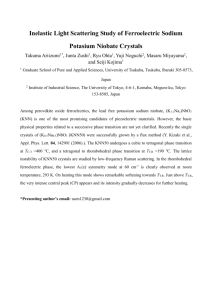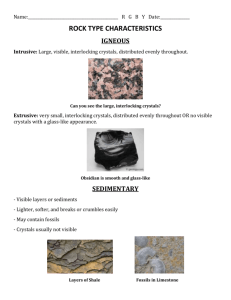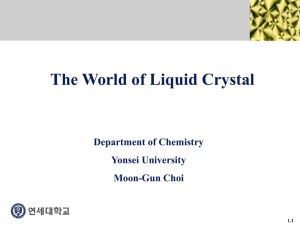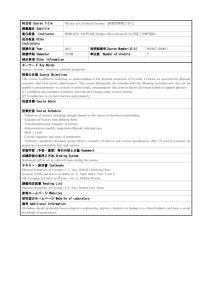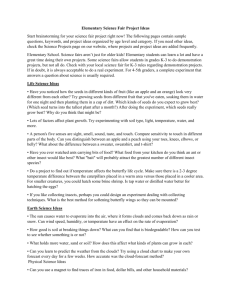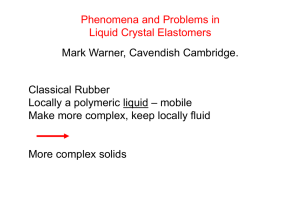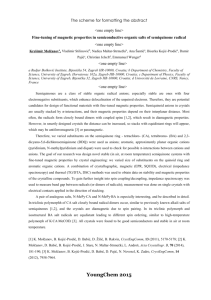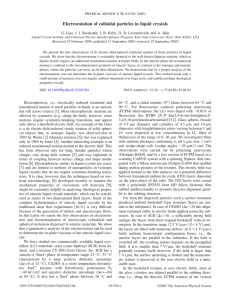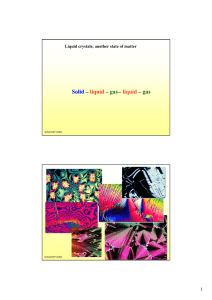Synthesis and Properties of Novel Liquid Crystal Materials with
advertisement
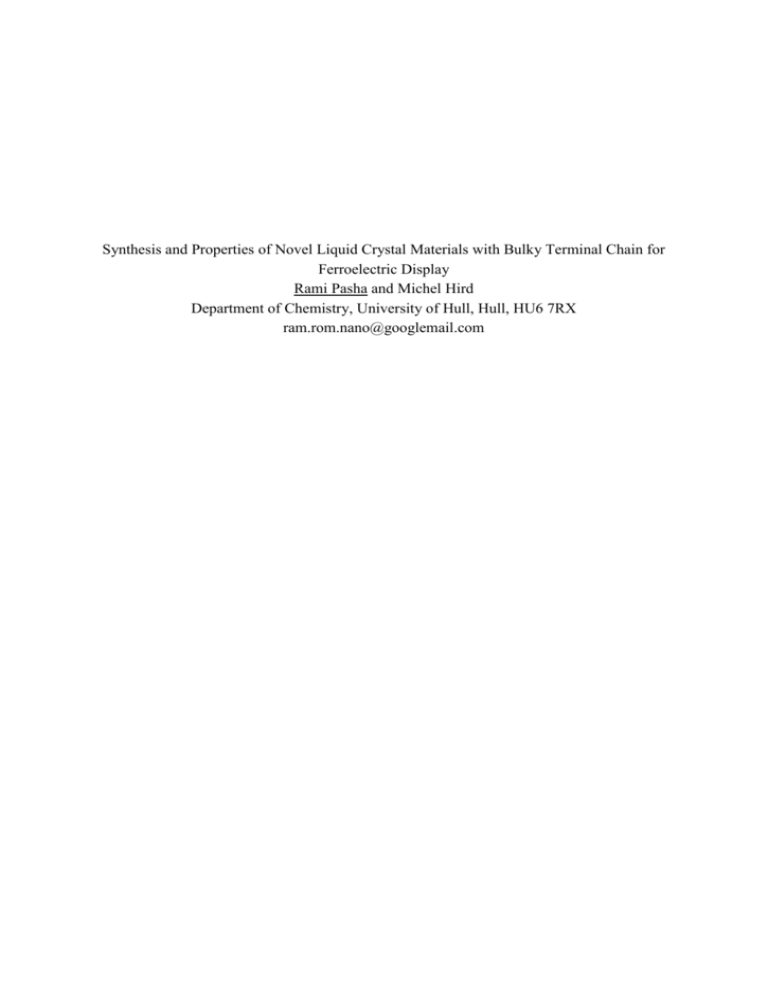
Synthesis and Properties of Novel Liquid Crystal Materials with Bulky Terminal Chain for Ferroelectric Display Rami Pasha and Michel Hird Department of Chemistry, University of Hull, Hull, HU6 7RX ram.rom.nano@googlemail.com Background In 1975, Meyer et al.1 using symmetry arguments demonstrated that chiral tilted smectic phases were ferroelectric i.e. displayed a spontaneous polarisation. When the molecules are achiral the environmental symmetry of the smectic C phase consists of a centre of symmetry, a two-fold axis and a mirror plane containing the molecular tilt and perpendicular to the layers. The group symmetry of the plan is C2h (Figure 1). When the molecules of smectic C phase are chiral, the symmetry is reduced to a two-fold axis2 of rotation and the group symmetry is now C2. The dipoles associated with the environment about the chiral centres align because of molecular interactions, and this results in a spontaneous polarisation, Ps, that develops along the C2 axis of the phase. Displays using ferroelectric smectic C liquid crystals offer numerous advantages over nematic based displays. Ferroelectric liquid crystal devices are faster switching than nematic based displays devices, they can also provide higher resolution over a large display area and a better viewing angle. However, the physical criteria for a ferroelectric smectic C material to be suitable for display applications are harder to satisfy than for nematic materials used in4 twisted or supertwisted devices. The method most often chosen to produce ferroelectric mixtures is to use mixtures of achiral materials doped with a chiral compound to provide the possibility of spontaneous polarisation when the helical structure is suppressed5-7. Purpose - Synthesize novel smectic C host materials, and matched dopants, to generate ferroelectric mixtures, ultimately with the expectation of true bookshelf geometry. Study its properties and measure its Ps and tilt angle. - Base the novel materials on known successful smectic C host materials, such as orthodifluoroterphenyls. Method The general preparation of multi-aryl core compound with two terminal chains and several lateral fluoro substituents cannot possibly be accomplished from the core unit directly. The introduction of structural units into a phenyl ring is most often achieved using electrophilic substitution reaction. The range of units that can be introduced is somewhat limited, however subsequent functional group interconversions can give a vast array of substituents. The electrophhilic substitutions in an aryl ring are directed and rate-determined by the already present substituents. Hence, the number of substituents required in an aryl ring is increased, the chance of that a substituent will be directed to an undesired position becomes ever greater. Additionally, steric hindrance will limit the chances of a substituent to be directed to a desired position in the ring. In biphenyls and terphenyls, the scope for electrophilic substitutionis very stricted because the positions in the bay regions of the core (i.e., the 2- and 2’and 2’’-positions) are sterically hindered by the ring structure itself, hence substitution is very unlikely. The introduction of a terminal chain such as an alkyl or alkoxy chains (which are used in this work as terminal chains) into a biphenyl or a terphenyl core will activate positions in the terminal rings to further substitution. With all these facts in mind, alternative methods were required for preparing the terrphynals materials with lateral fluoro substituents. The alternative methods involve the initial synthesis of the individual ring units and the subsequent systematic linking of these units to provide the desired multi-aryl final product materials. Many methods of generating carboncarbon bonds between aryl units have now been developed to a suitable standard of high products yields and operational simplicity to allow their widespread use in synthetic organic chemistry. Most such methods use two aryl units one having a leaving group or substituent and the other aryl unit is an organometallic unit. The two aryl units can then be coupled together in the presence of a transition metal catalyst which contains suitable ligands. One of the most useful catalyst is tetrakis(triphenylphosphine)palladium(0) Pd(PPh3)4. Iodo, bromo and chloro can be leaving groups as well as triflate and tosylate, however arylboronic acids are the most successful organometallic units in the synthesis of liquid crystals. 275 225 Iso 175 N Sm A 125 Sm C 75 Crystal C 55 C 51b C 43b C 43a C 40b C 40a C 35b C 35a C 32b C 32a C 25 C 17b C 17a C 10b C 10a 25 Chart 1, shows the difference between Discussion and conclusion The final products were synthesized according to the synthetic schemes illustrated (Chart 1), or by using very similar routes. The discussion of the mesophase morphology and transition temperature (°C) of the materials shown in Figures 4 and 5 can be summarised in some points11, (a) Alkoxy terminal chain compounds generally have higher melting points and higher phasetransition temperatures than alkyl compounds . (b) Compounds with the two fluoins in the end rings e.g, compounds 10a and 10b rather than in the centre ring e.g, compounds 17a and 17b have higher melting points and higher phasetransition temperatures. References 1.R. B. Meyer, L. Liebert, L. Strzelecki and P. Keller, Journal De Physique Lettres, 1975, 36, L69-L71. 2.R. B. Meyer, Molecular Crystals and Liquid Crystals, 1977, 40, 33-48. 3.G. Y. Cosquer, Ph.D Thesis, Unuversity of Hull, England, 2000. 4.D. M. Walba, D. J. Dyer, X. H. Chen, U. Muller, P. Cobben, R. F. Shao and N. A. Clark, Molecular Crystals and Liquid Crystals Science and Technology Section a-Molecular Crystals and Liquid Crystals, 1996, 288, 83-91. 5.N. A. Clark and T. P. Rieker, Phys Rev A, 1988, 37, 1053-1056. 6.T. P. Rieker, N. A. Clark, G. S. Smith, D. S. Parmar, E. B. Sirota and C. R. Safinya, Physical Review Letters, 1987, 59, 2658-2661. 7.I. Dierking, L. Komitov and S. T. Lagerwall, Liquid Crystals, 1998, 24, 769-774. 8.M. Hird, in FLC, Japan, Editon edn., 2007. 9.N. Miyaura, T. Yanagi and A. Suzuki, Synthetic Communications, 1981, 11, 513. 10.M. Hird, G. W. Gray and K. J. Toyne, Molecular Crystals and Liquid Crystals, 1991, 206, 187.

